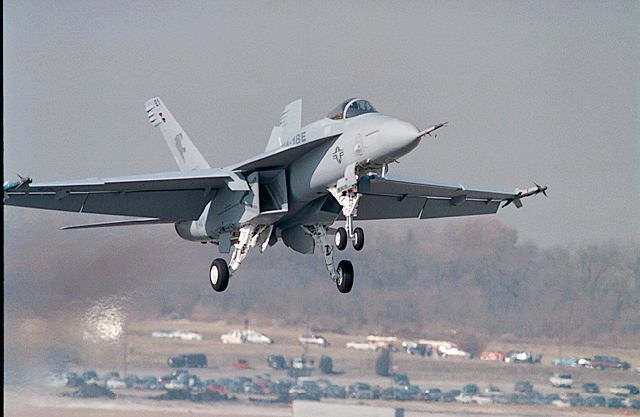
ITALERI 1:72 F/A-18E SUPER HORNET

Reviewer: Craig Caldwell (rec.models.scale)
Not due to enter service until the year 2002, the "Super Hornet" (aka as "Super Bug" and "Killer Hornet") is quite simply an improved version of the current model F/A-18C Hornet. It features revised intakes that are now box-shape (like those on the Tomcat and Eagle) and the aircraft is also larger in size, specifically length. The F/A-18E is touted to also have an improved weapons load - with an additional pair of stores stations - and increased range, and overall fix up some shortcomings on its predecessor.For a 1/72 kit there are a lot of parts in the box, just under 150 of them! They are crisply injected molded in grey with a very small amount of flash requiring to be cleaned up. Panel lines are engraved and surface detail is overall quite good, although a few ejector pin marks are evident.
Instructions are set out in the now familiar Italeri fold out sheet design that always seems to have page creases where you don't want them! There are about a dozen steps to follow, all in generally good detail although a couple of areas, such as installation of the small inlets, are vague in positioning.
Construction starts with a cockpit that would be defined as 'reasonable', certainly nothing to write on the wall about. The ejection seat is replicated quite well but the side consoles are a little unrealistic in my book. The instrument panel is fair, but does feature raised console detail that gives good effect when dry-brushed. Everything fits where it is supposed to and the cockpit unit assembles inside the fuselage rather well. The canopy itself can be fixed in the open or closed position as well.
Fit of the major components such as wings, fuselage and tailplanes is quite good, as are all the parts overall. A small amount of filling and sanding was called upon with the wing roots and joining the front and rear fuselage sections. The kit allows positioning of leading-edge inlets and the speed brakes as options. However, the kit has a dorsal speed brake between the twin fins and according to rollout pictures of the F/A-18E this was not actually installed. I therefore closed this component, filled in and and sanded the seams so that the speed brake was not visible on the model.
But when you talk of F/A-18 kits, you are most likely going to come across problems when accurately depicting the intakes - even with the revised box shape, this kit is no exception. Gaps between the Intake joints had to be filled and sanded and I spent quite a bit of time trying to fix the intake section on correctly. This kit certainly didn't have the problems of other rounded intake F/A-18 kits, but still was a bit of a challenge. The kit comes appropriately packed with an array of stores to use that includes Sidewinders, Harpoons, SLAM-ers, HARMs, FLIR pod, AMRAAM and a centreline fuel pod.
The undercarriage was assembled and painted separately before being fixed to the aircraft. One problem in the instructions I noted when again referring to pictures of the Super Hornet, was that the nose-gear door should be mounted on right side of the wheel bay, not left as it is depicted in the sheet.
Decals supplied in the kit are the markings for the rollout F/A-18E shown in 1996. This features two tone low-vis grey scheme with dark grey markings and insignias on the outer wing panels. This is where it is handy to know your aircraft and have reference material available. Italeri suggest the insignias to be placed on inner panels and have also replicated the markings in light grey and these would soon become invisible on the low-vis grey. Thankfully one can get hold of some aftermarket sets and improvise to suit the aircraft. I know that Revell have produced an F/A-18E kit (which I understand is a rebox of this Italeri kit?) so I wonder if their decals are any different?
Overall this was quite a reasonable project and I would recommend it to all skill levels of modelling with one exception - the intakes. Most of the kit was quite straightforward to put together but extra time and effort was spent on the intakes. The kit measures out quite accurately and I have no major gripes with it other than those as touched on in this review. The rule of thumb with this kit is to be on your toes and be warned that a few anomolies (perhaps one or two that even I didn't spot) need to either be overcome or lived with.
Reference material I used for this project included Janes Directory of Modern Militay aircraft, updated catalog of fighters, World Air Power Journal '96 and Air Forces Monthly magazine. Yes, I would build another one when different markings and schemes can be used on the aircraft!
Related Inbox reviews: Italeri 1/72 F/A-18E Super Hornet : Revell 1/72 F/A-18E Super Hornet
Back to home
Kit Review Index: 1/72
1/48

Photo Credit: Unknown
On its rollout, the F/A-18E Super Hornet prototype
NB: see related reviews above, those inbox reviews have more E-model pics.